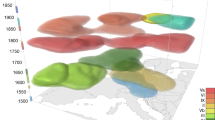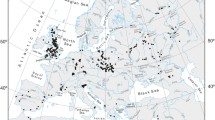Abstract
Several studies show that the El Niño-Southern Oscillation (ENSO) is an important factor in determining interannual rainfall variability in South America. This signal is detected in the region including Northeastern Argentina, Uruguay and part of southern Brazil, in the form of excessive rains and big floods in the regional rivers. To check that this relationship was similar in the past the objectives of this paper were to construct a time series of large floods in the Paraná River region from documentary records, during the sixteenth to eighteenth centuries, and to evaluate the relationship between that historical record of extreme floods, the ENSO documentary evidence (Ortlieb, The Documented Historical Record of El Niño Events in Perú: An Update of the Quinn Record (Ortlieb, sixteenth through nineteenth centuries, Diaz and Markgraf, (eds.), El Niño and the southern oscillation. Multiscale variability and global and regional Impacts. Cambridge University Press, pp. 207–295, 2001; Quinn and Neal, The historical record of El Niño events, Bradley and Jones (eds.), Climate since a.d. 1500, Routledges, pp. 623–648, 1992) and the temperature index of the Pacific Ocean (Mann ME et al., Global temperature patterns in past centuries: an interactive presentation, IGBP pages/world data center for paleoclimatology data contribution series #2000-075. NOAA/NGDC Paleoclimatology Program, Boulder CO, USA, 2000). Considering that the period 1904–2000, where 11 out of 16 floods occurred during El Niño events, it can be concluded that the proportion of years with exceptional flow volume in the Paraná River in years with El Niño events in the seventeenth and eighteenth centuries was relatively lower than that of the twentieth century. The reason for this difference is discussed.
Similar content being viewed by others
Abbreviations
- AGI:
-
Archivo General de Indias, Sevilla
- AGN:
-
Archivo General de la Nación Argentina
- RAH:
-
Real Academia de la Historia–Madrid
- ACSF:
-
Actas Cabildo de la Ciudad de Santa Fe
- CA:
-
Cartas Anuas de los Jesuitas
- ACC:
-
Actas Capitulares de Corrientes
PUBLISHED SECONDARY HISTORICAL SOURCES
Acosta J. de: 1954, Obras del Padre José Acosta de la Compañía de Jesús. Biblioteca de autores españoles, LXXM, Atlas. Madrid.
Actas Capitulares de Corrientes: 1941–1942, Prólogo de Ricardo Levene, Academia Nacional de la Historia, Buenos Aires, 2 t.
Actas del Cabildo de la Ciudad de Santa Fe: 1942, Primera Serie, Tomos I y II, Junta Provincial de Estudios Históricos de Santa Fe, Impr. de la Prov. Santa Fe, Santa Fe.
Actas del Cabildo de la Ciudad de Santa Fe: 1942, Segunda Serie, T I, Junta Provincial de Estudios Históricos de Santa Fe, Impr. de la Prov. Santa Fe, Santa Fe.
Cartas Anuas de la Provincia del Paraguay, Chile y Tucumán de la Compañía de Jesús: 1927, Documentos para la Historia Argentina, XIX–XX, Iglesia, Fac. de Filosofía y Letras, Buenos Aires.
Cervera M.: 1907, Historia de la ciudad y provincia de Santa Fe, 1573–1853, Librería La Unión ed, Santa Fe.
Dobrizhoffer M.: 1967, Historia de los Abipones, Fac. de Humanidades, Universidad del Nordeste, 3 t.
Fernández de Oviedo J.: 1959, Historia General y Natural de las Indias (1596), Biblioteca de Autores Españoles, CXVI11, Atlas, Madrid.
Furlong Guillermo SJ: 1938, Entre los Abipones del Chaco. Según noticias de los misioneros jesuitas Martín Dobrizhoffer, Domingo Muriel, José Brigniel, Joaquín Caamaño, José Jolís, Pedro Juan Andreu, José Cardiel y Vicente Olcina, Talleres Gráficos San Pablo, Buenos Aires.
Gandia, Enrique de: 1932, Historia de la Conquista del Río de la Plata y del Paraguay, García Santos, Buenos Aires.
Lozano Pedro: 1874–1878, Historia de la conquista del Paraguay, Río de la Plata y Tucumán 1, Imp. Popular, Buenos Aires.
Muhn Juan SJ: 1946, La Argentina vista por viajeros del siglo XVIII, Biblioteca Enciclopedia Argentina, 7, Ed. Huarpes, Buenos Aires.
References
Aceituno P, Montecinos A (1993) Análisis de la estabilidad de la relación entre la Oscilación del Sur y la precipitación en América del Sur. Bull Inst Fr Études Andines 22(1):53–64
Atlas Total de la República Argentina (1982) Atlas Físico, vol 2. Centro Editor de América Latina, Buenos Aires
Barros V, Berberis H (2002) Report Pilot Project: Floods in the Plata Basin, Impacts and Climate Forcing, Program for the Study of Regional Climate Variability, their Prediction and Impacts in the Mercosur Area (PROSUR) IAI Project CRN 055.http://prosur.cima.fcen.uba.ar/documentos
Camilloni IA, Barros VR (2003) Extreme discharge events in the Paraná River and their climate forcing. J Hydrol 278:94–106
Gentile E (1994) El Niño no tiene la culpa: Vulnerabilidad en el Noreste Argentino, Desastres y Sociedad, Revista semestral de La Red de Estudios Sociales, Agosto/Diciembre
Grimm A, Barros V, Doyle M (2000) Climate variability in southern South America associated with El Niño La Niña events. J Climate 13:35–58
Herrera RG, Prieto MR, García Herrera R (2003) Floods in the semiarid Argentinean Chaco during the 17th to 19th centuries. In: Thorndycraft VR, Benito G, Barriendos M, Llasat M (eds) Proceedings of palaeofloods, historical data & climatic variability: applications in flood risk assessment. CSIC-Centro de Ciencias Medioambientales, Madrid
Mann ME et al. (2000) Global temperature patterns in past centuries: an interactive presentation, IGBP pages/world data center for paleoclimatology data contribution series #2000-075. NOAA/NGDC Paleoclimatology Program, Boulder CO, USA
Montecinos A, Diaz A, Aceituno P (2000) Seasonal diagnostic and predictability of rainfall in subtropical South America based on tropical pacific SST. J Climate 13:746–758
Ortlieb L (2001) The documented historical record of El Niño events in Perú: an update of the Quinn record (sixteenth through nineteenth centuries). In: Diaz HF, Markgraf V (eds) El Niño and the Southern Oscillation, Multiscale variability and global and regional impacts. Cambridge University Press, pp 207–295
Prieto MR, Richard R (1991) Anomalías climáticas en la Cuenca del Plata y el NOA. Siglos XVI, XVII y XVIII. Leguas. Revista Argentina de Geografía 1:41–103. UNCU, Fac. Filosofía y Letras, Mendoza
Quinn H, Neal VT (1992) The historical record of El Niño events. In: Bradley R, Jones P (eds) Climate since a.d. 1500. Routledge, London, pp 623–648
Ropelewski CF, Halpert MS (1987) Global and regional scale precipitations pattern associated with El Niño/Southern Oscillations. Mon Wea Rev 115:1606–1626
Author information
Authors and Affiliations
Corresponding author
Rights and permissions
About this article
Cite this article
Prieto, M.d. ENSO signals in South America: rains and floods in the Paraná River region during colonial times. Climatic Change 83, 39–54 (2007). https://doi.org/10.1007/s10584-006-9188-1
Received:
Accepted:
Published:
Issue Date:
DOI: https://doi.org/10.1007/s10584-006-9188-1




